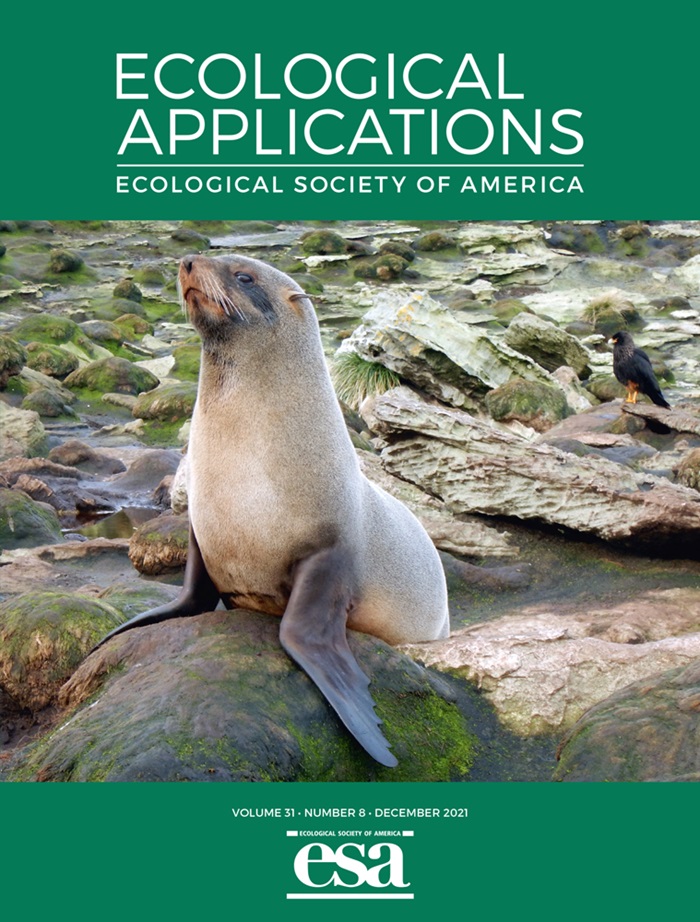Does tidal marsh restoration lead to the recovery of trophic pathways that support estuarine fishes?
IF 4.3
2区 环境科学与生态学
Q1 ECOLOGY
引用次数: 0
Abstract
Evaluation of tidal marsh restoration success is typically based on the recovery of habitat size and target species. However, food-web structure may provide valuable insight into ecosystem functioning trajectories. Here, we studied restored tidal marshes of different ages (new, young, old; spanning 1-150 years) in comparison with nearby reference sites along the San Francisco Estuary. We asked: (1) How does restoration help recover energy pathways that support fishes? (2) Do fishes rely more on algal versus detrital pathways in restored sites?; and (3) How does food-web structure vary as a function of species origin and life history? To answer these questions, we sampled fish (n = 806) and basal resources (emergent vegetation and phytoplankton; n = 109) seasonally over two hydrologically contrasting years. Using stable isotopes (δ13C, δ15N, and δ34S), we calculated fish isotopic niche volumes, food chain lengths, and the relative importance of algal versus detrital energy pathways. We found that food chains in restored sites were 8% shorter than in their paired reference sites. Additionally, the young and old restored sites had 37% smaller niche volumes than their references, but the opposite was true for the new restored site (11% larger), illustrating the characteristic trophic surge of early succession. Fishes found in restored sites relied significantly less on detrital energy (7% less) than fishes found in reference sites, and resident fishes showed 12% higher reliance on the detrital pathway than transient species. Finally, most of the native niche volume overlapped with that of introduced fish, which was in turn 38% larger, and a similar pattern was observed when comparing resident to transient fish. Our findings demonstrate that food-web structure does not immediately recover with tidal marsh restoration, even if fish assemblages are species-rich; and show that transient trophic surges may complicate restoration success assessments of newly restored marshes. We contend that incorporating recovery of energy pathways as an indicator of performance may help strengthen monitoring and design of wetland ecosystem restoration projects.潮汐沼泽的恢复是否会导致支持河口鱼类的营养通路的恢复?
潮汐沼泽恢复成功的评价通常基于栖息地大小和目标物种的恢复。然而,食物网结构可能为生态系统功能轨迹提供有价值的见解。在这里,我们研究了不同年龄的恢复潮汐沼泽(新的,年轻的,旧的;跨越1-150年),并与旧金山河口附近的参考地点进行了比较。我们的问题是:(1)恢复如何帮助恢复支持鱼类的能量途径?(2)在恢复后的环境中,鱼类是否更依赖藻类和碎屑途径?(3)食物网结构如何随着物种起源和生活史的变化而变化?为了回答这些问题,我们在两个水文对比年份对鱼类(n = 806)和基础资源(n = 109)进行了季节性采样。利用稳定同位素(δ13C、δ15N和δ34S),我们计算了鱼类同位素生态位体积、食物链长度以及藻类与碎屑能量途径的相对重要性。我们发现,在恢复的地点,食物链比配对的参考地点短8%。此外,年轻和年老恢复样地的生态位体积比参考样地小37%,而新恢复样地的生态位体积比参考样地大11%,说明了早期演替的典型营养激增。在恢复点发现的鱼类对碎屑能量的依赖明显低于参考点(7%),而在恢复点发现的鱼类对碎屑途径的依赖比瞬时物种高12%。最后,大部分本地生态位体积与引进鱼的生态位体积重叠,引进鱼的生态位体积比引进鱼大38%,而本地生态位体积与引进鱼的生态位体积相似。我们的研究结果表明,即使鱼类组合物种丰富,食物网结构也不会随着潮汐沼泽的恢复而立即恢复;并表明短暂的营养激增可能使新恢复沼泽的恢复成功评估复杂化。我们认为,将能量路径的恢复作为绩效指标有助于加强湿地生态系统恢复项目的监测和设计。
本文章由计算机程序翻译,如有差异,请以英文原文为准。
求助全文
约1分钟内获得全文
求助全文
来源期刊

Ecological Applications
环境科学-环境科学
CiteScore
9.50
自引率
2.00%
发文量
268
审稿时长
6 months
期刊介绍:
The pages of Ecological Applications are open to research and discussion papers that integrate ecological science and concepts with their application and implications. Of special interest are papers that develop the basic scientific principles on which environmental decision-making should rest, and those that discuss the application of ecological concepts to environmental problem solving, policy, and management. Papers that deal explicitly with policy matters are welcome. Interdisciplinary approaches are encouraged, as are short communications on emerging environmental challenges.
 求助内容:
求助内容: 应助结果提醒方式:
应助结果提醒方式:


